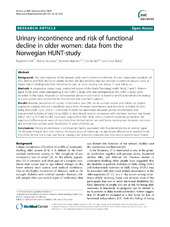| dc.contributor.author | Omli, Ragnhild | en_US |
| dc.contributor.author | Hunskår, Steinar | en_US |
| dc.contributor.author | Mykletun, Arnstein | en_US |
| dc.contributor.author | Romild, Ulla Kristina | en_US |
| dc.contributor.author | Kuhry, Esther | en_US |
| dc.date.accessioned | 2014-05-09T09:24:49Z | |
| dc.date.available | 2014-05-09T09:24:49Z | |
| dc.date.issued | 2013-05-16 | eng |
| dc.identifier.issn | 1471-2318 | |
| dc.identifier.uri | https://hdl.handle.net/1956/7922 | |
| dc.description.abstract | Background: The main objective of the present study was to determine whether UI is an independent predictor of ADL decline and IADL decline in elderly women. We also aimed to find out whether incontinent subjects were at higher risk of needing help from formal home care or home nursing care during 11 year follow-up. Methods: A prospective cohort study conducted as part of the North-Trøndelag Health Study 2 and 3. Women aged 70–80 years when participating in the HUNT 2 study, who also participated in the HUNT 3 study, were included in this study. Analyses on self-reported urinary incontinence at baseline and functional decline during a 11-year period were performed for incontinent and continent subjects. Results: Baseline prevalence of urinary incontinence was 24%. At on average eleven year follow up, logistic regression analysis showed a significant association between incontinence and decline in activities of daily living (ADL) (OR =2.37, 95% CI =1.01-5.58) (P=0.04). No association between urinary incontinence and instrumental activities of daily living (IADL) in incontinent women compared with continent women was found (OR=1.18, CI=.75-1.86) (P=.46). Data were adjusted for ADL, IADL and co morbid conditions at baseline. No significant differences in need of more help from formal home care and home nursing care between continent and incontinent women were found after 11 years of follow-up. Conclusions: Urinary incontinence is an important factor associated with functional decline in women aged 70–80 years living in their own homes. At eleven years of follow up, no significant differences in need of more help from formal home care and home nursing care between continent and incontinent women were found | en_US |
| dc.language.iso | eng | eng |
| dc.publisher | BioMed Central | eng |
| dc.rights | Attribution CC BY | eng |
| dc.rights.uri | http://creativecommons.org/licenses/by/2.0 | eng |
| dc.title | Urinary incontinence and risk of functional decline in older women: data from the Norwegian HUNT-study | en_US |
| dc.type | Peer reviewed | |
| dc.type | Journal article | |
| dc.date.updated | 2013-08-23T08:50:24Z | |
| dc.description.version | publishedVersion | en_US |
| dc.rights.holder | Ragnhild Omli et al.; licensee BioMed Central Ltd. | |
| dc.rights.holder | Copyright 2013 Omli et al.; licensee BioMed Central Ltd. | |
| dc.source.articlenumber | 47 | |
| dc.identifier.doi | https://doi.org/10.1186/1471-2318-13-47 | |
| dc.identifier.cristin | 1044330 | |
| dc.source.journal | BMC Geriatrics | |
| dc.source.40 | 13 | |

